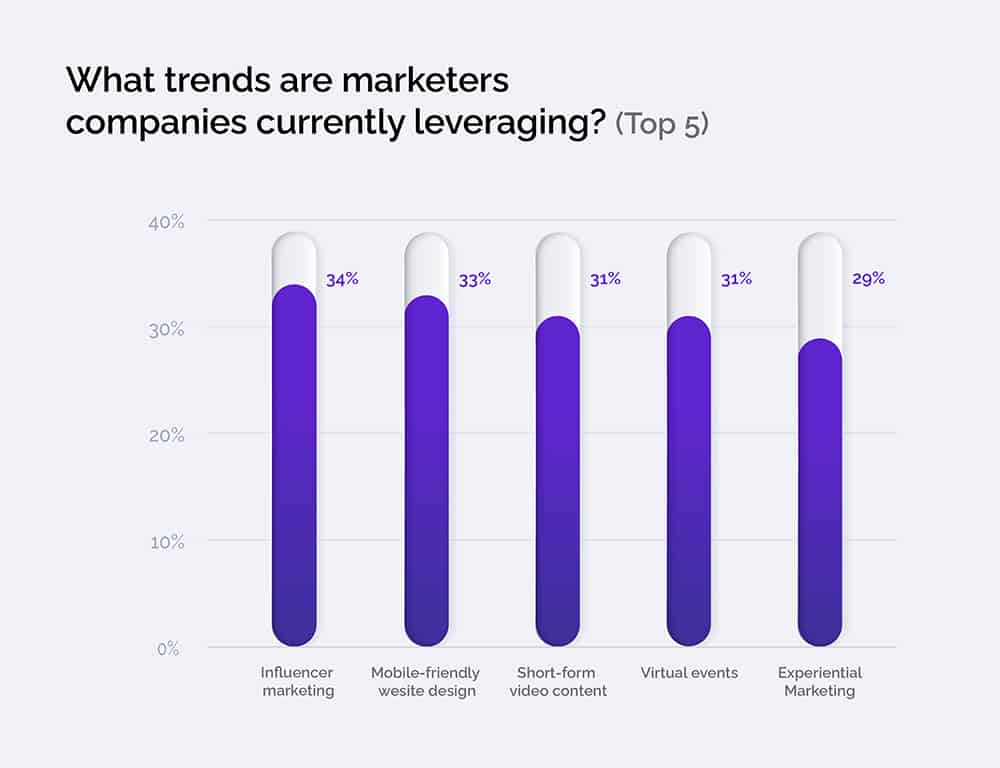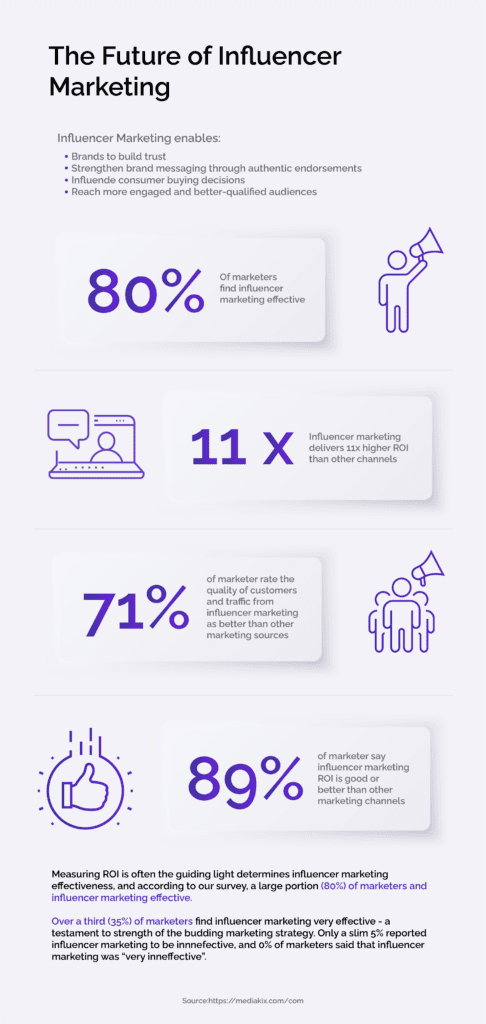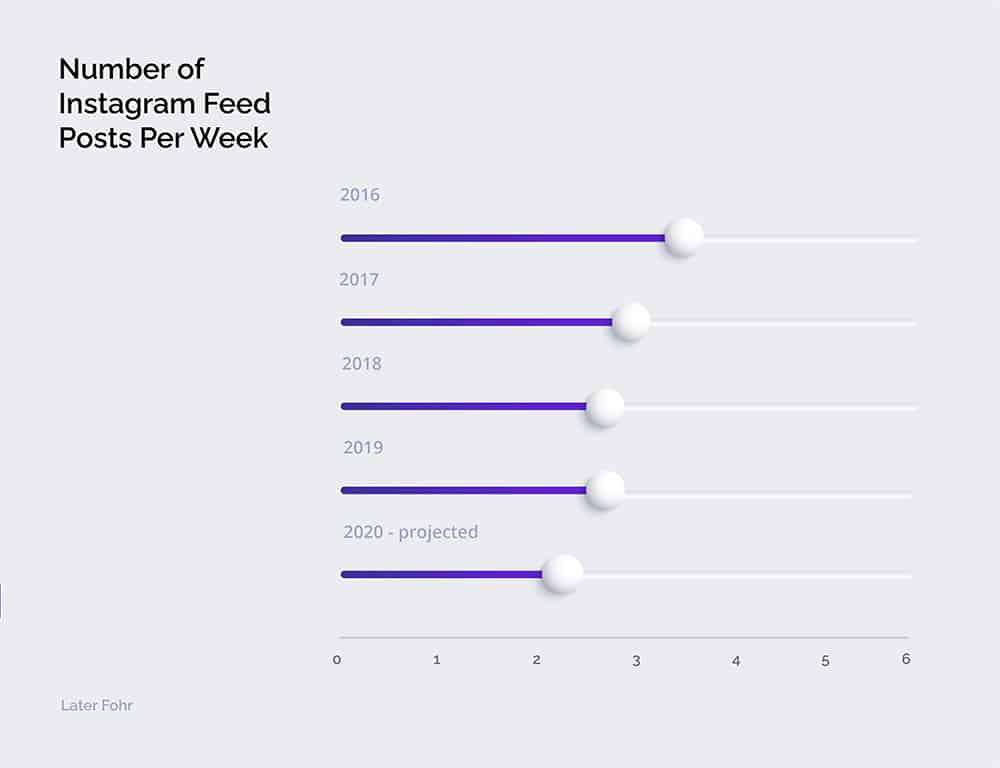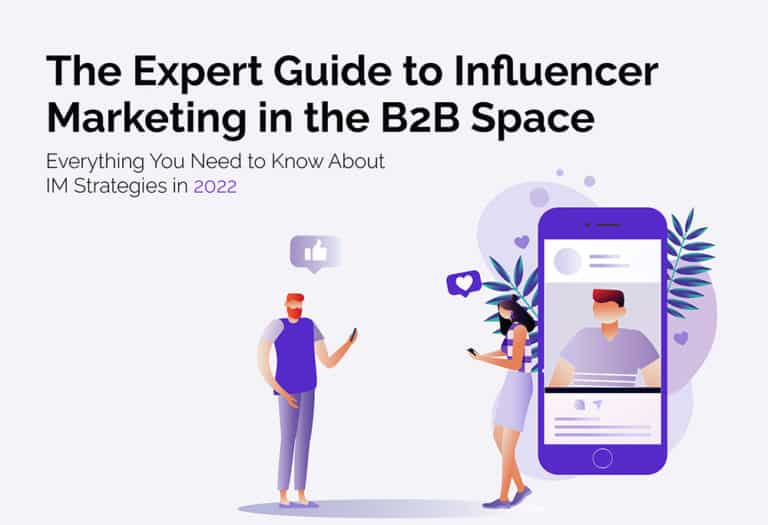Leading influencer marketing trend watchers expect this market to cross $22 billion in revenues by the end of 2022 — a higher figure even than branded social media marketing.
And Hubspot’s 2022 Marketing Industry Trends report found that influencer marketing was the top strategy that marketers plan to use this year.

This is true even for brands that hadn’t considered it until recently, partly because of the explosion of smaller or niche influencers across social media platforms.
These can be employees, customers, or industry experts, and they don’t need to have a huge following. They do, however, need an engaged following.
Working with these micro-influencers to reach a highly targeted segment of your audience offers a high ROI, while still being budget-friendly.
Still not convinced working with influencers is a lucrative marketing strategy for your business? Companies are making $5.20 for every $1 spent on influencer marketing, reports InfluencerHub. Now that’s an ROI that will show you the money.
So the short answer to whether B2B influencer marketing is worth the money? YES. According to a Nielsen study with TapInfluence, influencer marketing for B2B yielded 11x the ROI of traditional advertising.
If you’re ready to get started with B2B influencer marketing, there are a few things you need to know:
- What it is.
- How it works.
- How to find B2B influencers.
- How to measure it.
In this post, we’ll answer the top seven most frequently asked questions on integrating influencer marketing into your B2B marketing mix, so you can make sure your B2B influencer marketing strategy pays off this year.
What is influencer marketing?
Influencer marketing has lots of similarities to word-of-mouth marketing.
Brands partner with influencers — social media users who have lots of engaged, interested followers within a specific niche or audience — to promote the brand’s product or service through their social channels. Depending on the extent of the campaign, that could mean posting a single image of the influencer using your product, or a series of blog posts detailing their experience with your service.
Either way, the goal is the same: get your brand out in front of the influencer’s audience in a way that builds trust with that audience.
This partnership can influence purchase decisions for millions of followers. It’s the way to develop credibility and create social proof that your products or services are liked, works, and delivers on their promises, much like word-of-mouth used to do before the digital age.

How does influencer marketing work?
Francesca Cruz, VP of Sales for TapInfluence, said, “Great content is expensive to create, and yet it rarely gets seen because most companies publish it on their channels. Brands end up paying for distribution and content creation.
Influencer marketing, however, delivers both content creation and distribution for a much lower price, and is more authentic, more engaging, and drives ROI at an order of magnitude greater than all other forms of digital media.”
How does B2B influencer marketing work and how is it different from B2C?
Surely as a business owner, you have noticed that paid advertising seems to be getting both more expensive and less effective.
Enter influencer marketing. Influencer marketing offers the ability to speak on your product’s behalf authentically, and it can help your sales go up while costs go down.
As Jay Baer says, “There are some critical challenges with this type of marketing, including scalability, disclosure, and the tendency of companies to confuse influence with the audience when selecting persons with whom to align. But the genie is not going back in the bottle. With hundreds of influencer marketing software firms in play, powered by venture capital, this is a marketing sub-genre that’s going to be around a while.”
As with any marketing strategy, there are certain things every B2B tech brand needs to consider when starting an influencer marketing campaign. Here are the top three:
Top Considerations for B2B Brands Creating an Influencer Marketing Strategy
1. B2B influencer marketing strategies require longer timelines than B2C.
As a B2C company, you can post a skincare item online with an influencer and see sales spike within the first 30 days of creating the campaign. B2B purchases can typically take longer and include more decision-makers; therefore, the timeline could be six months or more before results are seen.
2. Know who your customers are listening to, following, watching, and reading.
Once you determine who these people are, you may find that they are the best voice for your business – even if they don’t have huge follower counts.
But especially for B2B, it’s not all about the numbers. What matters more than the number of followers an influencer has is their audience’s engagement levels. Partnering with a micro-influencer who has 1,500 highly engaged followers will almost always be more effective than working with a mega-influencer who has millions of followers who rarely comment, like, or do much more than scroll past that influencer’s posts.
3. You’ll likely have to find the influencers, rather than the influencers finding you.
Of course, having a perfect-fit influencer approach your brand to initiate a partnership is a dream come true for most businesses. But realistically, you’ll have to take the first step, by doing research on various social platforms or using a dedicated influencer marketing platform.
Now, some of the most successful influencer programs in history turn this relationship on its head. In these cases, the company created enough great content and community that influencers show up and participate without being asked to do so.
In 2016 that’s precisely what happened to Southwest Airlines. Branden first showed up in their feed due to his frequent traveling, and that partnership paved the way for their current 2019 Storyteller campaign.
“Meet Branden. Branden’s love affair with Southwest began years ago when he started dating a lovely girl named Sammi long distance. He was in Portland; she was in Nashville. Countless flights later, he’s now married to that lovely girl.
Make sure to stay tuned here on Facebook as Branden shares stories of the fascinating people he meets on Southwest flights for the rest of the year. You can also follow along with Branden’s travels on Instagram and Snapchat.”
How do you measure the ROI of B2B influencer marketing?
Setting goals is one of the most critical pieces of any successful digital campaign, and influencer marketing is no different.
So what are your goals for your influencer campaign? If you’re struggling, here are a few common goals for a B2B influencer marketing campaign:
- Increase brand awareness
- Reach new target audiences
- Increase sales
- Manage brand reputation
To measure these you’d want to use metrics like:
- Clicks
- Impressions
- Conversions
- Sales
A best practice to apply when working with an influencer is to choose someone whose goals align with yours. That way, if you planned to reach a certain sales level during a particular time, the influencer is also working toward that goal as well in their business.
How do you track and find B2B influencers?
Ultimately, tracking is the next big concern for marketers who use influencers. Believe it or not, there is an app for that. Take advantage of the plethora of influencer marketing platforms available to streamline the manual work involved in managing the influencers in your campaigns.
Many of these platforms can help you set up and manage your campaigns with branded content. You should ensure that your platform can help you find genuine influencers and not people who’ve inflated their follower count with fake followers or bots. You should always conduct your own research on an influencer before beginning a partnership.
Here are a few platforms to choose from:
- Heepsy– One of the largest databases, of more than 7 million influencers
- The Room– Best for enterprises, agencies, charities, and startups
- Fourstarzz Media- Best for small businesses
Choosing the Right Influencer Marketing Platform
There are a few things to consider when looking for the best influencer marketing platform for your B2B brand:
1. What type of campaign are you looking to create?
Different platforms have different capabilities when it comes to creating campaigns. Some platforms are better for one-off campaigns, while others are better for long-term campaigns.
2. What’s your budget?
Not all platforms are created equally when it comes to price. Some platforms are free, while others have a subscription fee. You’ll want to find a platform that fits your budget.
The vital questions influencer marketing platforms should be able to answer are:
- Does the platform help with native advertising campaigns?
- Can it help you track the campaign results?
- Does it help you manage the influencer’s content?
A whopping 92% of consumers trust a personal recommendation from a friend. And that is a number that hardly any advertisement can beat. Influencer marketing is the word-of-mouth for product launches in 2021, delivering outstanding results.
How does influencer marketing ROI compare to other marketing channels?
Instagram is most famously known for its influencers, so much so that an estimated 71% of U.S. businesses today use Instagram. It’s the highest-growth network out there. Others are catching up like Snapchat, YouTube, and TikTok with their own set of influencers’ different demographics.

Regardless of the vehicle, crucial decisions need to be made for your IM campaign, and your budget may determine how you start.
Are you going for celebrities with massive followings? These posts can deliver big results, but they come with similarly huge price tags.
Or are you leaning more toward a micro-influencer, someone with less than 2000 followers?
Whatever you decide to focus on will determine your budget.
The compensation varies wildly, too, so be sure to look at standard rates for those influencer types. Micro-influencers tend to be focused on a few topics and highly selective with the products they promote (as they should be—influencers lose credibility immediately if they’re perceived to be promoting products they don’t believe in).
Some micro-influencers work independently, while an agency or network may represent others. In comparison, larger accounts and celebrities will need compensation and might even go through a talent agency.
After you decide on your brand-appropriate micro or mega influencer, your budget, timing, one final crucial piece to be determined is what content this influencer will be a part of on behalf of your brand.
How to leverage B2B influencers for greater success — trends in 2022
Here are eight types of content trending in 2022—consider these for your B2B influencer marketing strategy.
- Video Content Will Remain King
“The rise of Instagram Reels and the domination of TikTok the influencer smarting place with being more collaborative than ever.”
- A Focus on Diversity and Inclusion
“The goal for 2021 should be to build diversity and inclusion into all aspects of your business — including influencer marketing — to create effective change and illustrate your brand’s values.”
- The “No-Edit Edit” Will Evolve
“In 2021, we predict an increase in bloggers and influencers using the #nofilter trend. With a focus on authenticity, they’ll apply subtle edits to their photos to create an “in-the-moment” and unedited look into their lives.” @rohinielyse

- Value-Driven Content
“Now more than ever, people want to see your authentic self! I think providing some content that shows your real-life personality is key to growing online these days,” shared Rohini.
- More Ongoing Partnerships
Manu Muraro, the founder of Your Social Team, says one-off influencer posts or stories aren’t enough to bring results to most brands — “it takes 6 to 8 touches to make a sale.”
- A Focus on Micro and Nano Influencers
According to a 2019 report with Fohr, micro-influencers have the highest engagement rates (averaging at 7%) on their feed posts!
In fact, influencers with less than 25K followers had higher engagement rates regardless of their genre, target audience, or topics.
- New Social Platforms and Creator Tools
Nichole Ciotti predicts TikTok will be the platform to talk about this year. She also believes brands will be investing more money with popular creators on the platform:
“The natural virality their interface affords is going to enable brands to multiply their marketing efforts for the same dollars, especially with micro-influencers who produce amazing content, which has a high potential to get picked up by TikTok’s algorithm and go viral.”
- New Forms of Influencer Media
This year, we’ve already begun to see CGI-influencers pop up on our feeds, partnering with brands for the perfect #sponsored posts. One notable digital influencer, Lil Miquela, has 3M followers on Instagram.

Is investing in B2B influencer marketing worth the cash?
Given the data, it’s clear that the authentic promotion B2B influencers can offer is substantially more impactful than, say, a banner ad. This meshes with what we know about what consumers want today. They don’t want to be sold a product. They want to be entertained, educated, and informed. And B2B influencer marketing is precisely the way to do that.
So as you’re adjusting your marketing budget and strategy for this year, you can rest assured that with the right tools and approach, B2B influencer marketing will be well worth your hard-earned money.
Need help getting started? Contact Zen Media today.



